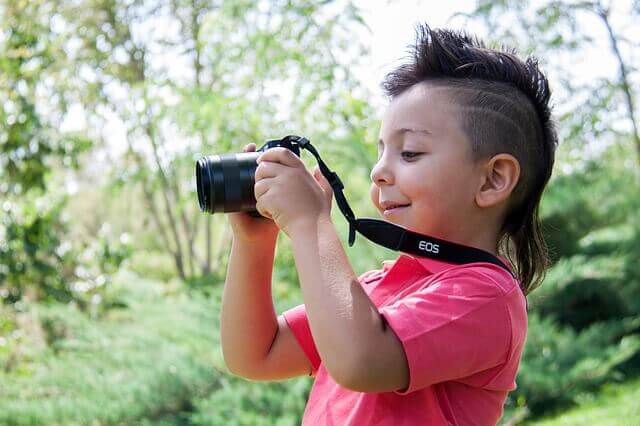The Benefits of Photography Courses for Children

Photography is an art that involves exercising and taking advantage of our creativity. For children, expressing themselves through photography is an opportunity to stimulate their capacity for observation and analysis, little by little. Of course, everything depends on their age. Keep reading and learn about the benefits of photography here.
Children are always curious about the world around them, and we should always try to support their creative potential through different forms of artistic expression. When children can see past a mere perceptual point of view, they start developing their cognitive abilities.
Photography allows children to express their feelings and thoughts about life. In turn, it helps them establish a deeper connection with their environment.
In fact, once they start photographing other people, they’ll have the opportunity to approach and interact with others from a much richer point of view, at a perceptual level.

The benefits of photography
As with other forms of artistic activity, photography allows children to express themselves freely. It’s an exercise in creativity that will even enable them to learn more about themselves.
When looking at a picture of a landscape, for example, they can become introspective about what motivated the photographer to take the shot.
Personal benefits of photography:
- Improves their observational capacity. Children will feel encouraged to observe their objective from different angles and take a photo from the best plane.
- Expands their horizons. Visualization is the best way to capture the right image. Pausing, observing thoroughly and taking shots from different perspectives will help make the final result impressive.
- Capturing images that give a three-dimensional sensation broadens their perspective.
- Stimulates their imagination and, therefore, their creative side. It’s not just a matter of taking a photo; it’s also about how you place the image so that it harmonizes and attracts attention.
- Helps them practice proper time management. Children will learn to take their time to get good results, but they’ll also learn not to get stuck on one idea if they want to take advantage of the light to take other shots and do other activities.
Social benefits of photography:
- Improves social interaction. One of the skills that a good photographer must master is empathy. Practicing photography teaches children the social skills needed to interact with their environment respectfully and calmly.
- Teaches children how to adapt quickly. A photographer must adjust to the environment; they may not always have a stage prepared for a photo session. There will be times when they’ll have to adapt to the environment and use whatever tools are within their reach. These challenges will help children gain the ability to adapt to any circumstance or unforeseen event.
What is the right age to learn photography?
There’s no specific moment to start taking advantage of the benefits of photography. However, if children feel an attraction and curiosity for a camera, take that opportunity to teach them the basics of photography.
And, once they’re 10-12 years old, you can enroll them in a photography course for people their age. This way, they’ll explore art in a way that’s appropriate for their abilities.
It’s not advisable to enroll children in a professional photography course or buy the most expensive camera to practice with. At first, the best thing is to allow them to use a simple, small and easy-to-use camera so that they’ll feel comfortable. Over time, they can get better equipment — one step at a time.

Advice for parents
It’s essential to value children’s photographs and encourage them to print them, as long as it’s economically possible. They should also be encouraged to create a portfolio on the computer and make homemade presentations with slides – especially, if they want to share their work and tell us the stories behind each of them.
On the other hand, it’s necessary to remind them that the most important thing is to be themselves; thus, they won’t feel afraid to experiment within the discipline.
At first, children learn while playing with the camera, but as time goes on, if we ask them to take a family photograph or simply motivate them to continue exploring this facet, they’ll be more professional and serious.
Learning photography is an entertaining activity that can become one of their hobbies or maybe even their job in the future. In time, the benefits of photography courses will become apparent.
Photography is an art that involves exercising and taking advantage of our creativity. For children, expressing themselves through photography is an opportunity to stimulate their capacity for observation and analysis, little by little. Of course, everything depends on their age. Keep reading and learn about the benefits of photography here.
Children are always curious about the world around them, and we should always try to support their creative potential through different forms of artistic expression. When children can see past a mere perceptual point of view, they start developing their cognitive abilities.
Photography allows children to express their feelings and thoughts about life. In turn, it helps them establish a deeper connection with their environment.
In fact, once they start photographing other people, they’ll have the opportunity to approach and interact with others from a much richer point of view, at a perceptual level.

The benefits of photography
As with other forms of artistic activity, photography allows children to express themselves freely. It’s an exercise in creativity that will even enable them to learn more about themselves.
When looking at a picture of a landscape, for example, they can become introspective about what motivated the photographer to take the shot.
Personal benefits of photography:
- Improves their observational capacity. Children will feel encouraged to observe their objective from different angles and take a photo from the best plane.
- Expands their horizons. Visualization is the best way to capture the right image. Pausing, observing thoroughly and taking shots from different perspectives will help make the final result impressive.
- Capturing images that give a three-dimensional sensation broadens their perspective.
- Stimulates their imagination and, therefore, their creative side. It’s not just a matter of taking a photo; it’s also about how you place the image so that it harmonizes and attracts attention.
- Helps them practice proper time management. Children will learn to take their time to get good results, but they’ll also learn not to get stuck on one idea if they want to take advantage of the light to take other shots and do other activities.
Social benefits of photography:
- Improves social interaction. One of the skills that a good photographer must master is empathy. Practicing photography teaches children the social skills needed to interact with their environment respectfully and calmly.
- Teaches children how to adapt quickly. A photographer must adjust to the environment; they may not always have a stage prepared for a photo session. There will be times when they’ll have to adapt to the environment and use whatever tools are within their reach. These challenges will help children gain the ability to adapt to any circumstance or unforeseen event.
What is the right age to learn photography?
There’s no specific moment to start taking advantage of the benefits of photography. However, if children feel an attraction and curiosity for a camera, take that opportunity to teach them the basics of photography.
And, once they’re 10-12 years old, you can enroll them in a photography course for people their age. This way, they’ll explore art in a way that’s appropriate for their abilities.
It’s not advisable to enroll children in a professional photography course or buy the most expensive camera to practice with. At first, the best thing is to allow them to use a simple, small and easy-to-use camera so that they’ll feel comfortable. Over time, they can get better equipment — one step at a time.

Advice for parents
It’s essential to value children’s photographs and encourage them to print them, as long as it’s economically possible. They should also be encouraged to create a portfolio on the computer and make homemade presentations with slides – especially, if they want to share their work and tell us the stories behind each of them.
On the other hand, it’s necessary to remind them that the most important thing is to be themselves; thus, they won’t feel afraid to experiment within the discipline.
At first, children learn while playing with the camera, but as time goes on, if we ask them to take a family photograph or simply motivate them to continue exploring this facet, they’ll be more professional and serious.
Learning photography is an entertaining activity that can become one of their hobbies or maybe even their job in the future. In time, the benefits of photography courses will become apparent.
All cited sources were thoroughly reviewed by our team to ensure their quality, reliability, currency, and validity. The bibliography of this article was considered reliable and of academic or scientific accuracy.
- Consejo Nacional de la Cultura y las Arte. (2015). El potencial educativo de la fotografía. Cuaderno pedagógico. Consejo Nacional de la Cultura y las Artes. Gobierno de Chile. https://www.cultura.gob.cl/wp-content/uploads/2016/01/cuaderno-fotografia.pdf
This text is provided for informational purposes only and does not replace consultation with a professional. If in doubt, consult your specialist.








